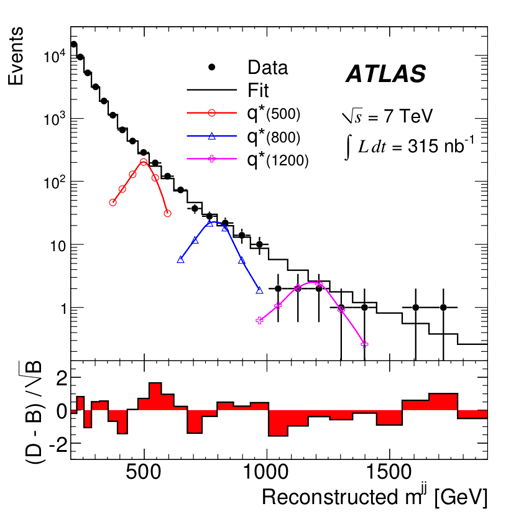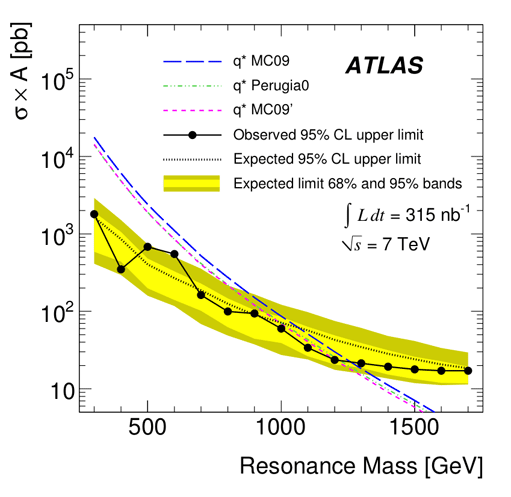
ATLAS e-News
23 February 2011
ATLAS sets world's best limits on q*
7 September 2010

Reconstructed dijet mass (filled points) fitted to a smooth background distribution, with predicted q* signal indicated at three different masses.
The ATLAS Experiment has recently set the world's best known limits for the mass of a hypothetical particle, q*. The analysis, which was undertaken by the Exotics group and accepted for publication by Physics Review Letters last week, represents ATLAS's first exclusion of physics outside the Standard Model and extends the scientific reach of previous experiments.
The original search, performed on a 315 nb-1 sample of 7 TeV centre-of-mass energy proton-proton collisions, scoured the data for new physics. Looking at the mass distribution of measured dijet events, analysts used six different model-independent statistical tests to hunt for telltale features – bumps, tails, or overall shape discrepancy in the plotted data – which would indicate something new and unexpected.
“Unfortunately we didn't find anything new,” reports analyst, Georgios Choudalakis, so the team went on to focus on one of the popular theories – that a dijet event could denote a decaying q* particle – and investigate what the mass of that theoretical particle might be (or, more correctly, what it might not be).
The q*, an 'excited quark', is both excited and exciting. For a quark to be able to be in an excited state implies that it is a composite particle as opposed to an elementary one.
“Observations so far indicate quarks to be point-like, with no visible inner structure. But with the energy we have today, we may be able to see if there is anything to excite 'inside' quarks,” explains Georgios.
They chose to scrutinise the q* rather than any of the other possible sources of dijet events because it has the highest probability of being produced at low integrated luminosity. In other words, it was the object that they could say the most about with the limited amount of data available to them. More importantly, q* is a 'benchmark' model, representative of a whole family of theories that predict similar signatures, described as 'narrow resonances'.
The maximum numbers of q* events that could have slipped through without being visible to the analysis were calculated for a range of q* masses by comparing with Monte Carlo production simulations. The thought process runs something like: “For this particular mass, at most there can be 10 events. If there were more than 10 events, then I would have seen [a signal]. It would be very unlikely to not have seen it.” Comparing these calculated maxima to theoretical predictions for q* production, the Exotics group were able to say at which mass the theories began to be incompatible with observation.
“Above this mass, theory starts predicting numbers which are allowed. But below this mass point, theory predicts [production] numbers which are too big,” explains Georgios, adding: “Beyond reasonable doubt – a 95 per cent confidence level – if excited quarks of this mass existed, they would have been seen. The fact that they were not seen means that the mass has to be different.”
According to ATLAS data, the mass of the q*, should it exist, will be outside of the range 0.30 TeV – 1.26 TeV. The lower limit denotes the edge of ATLAS's sensitivity, but the upper limit is the more interesting. The q* is expected to have a high mass since it will need to absorb energy (and therefore gain mass) to shift into an excited state.
The question of whether the quark is composite, whether there is anything inside it, has a long tradition. “That has been a paradigm in physics for millennia, reducing things to smaller and smaller building blocks,” says Georgios, “so there is no strong reason to believe that we have reached the bottom. If there is a bottom.”
A discovery of the quarks innards, 'preons', might provide insight on how quarks and leptons are interrelated – by elementary particles whose different combinations produce what science has observed to date – and if so, could offer a step towards a Grand Unified Theory.
For now though, ATLAS is able to say a little more about what the q* mass isn't, and has provided theorists with data in a new energy range, which they can use to test the limits of their own new models for any dijet final state narrow resonance.

The expected and observed upper limits of q* production as a function of dijet resonance mass. The intersection of the theoretical q* model curves (coloured dashed lines) with the measured values (black line with dots) determines new limits for each model.
 Ceri PerkinsATLAS e-News
|